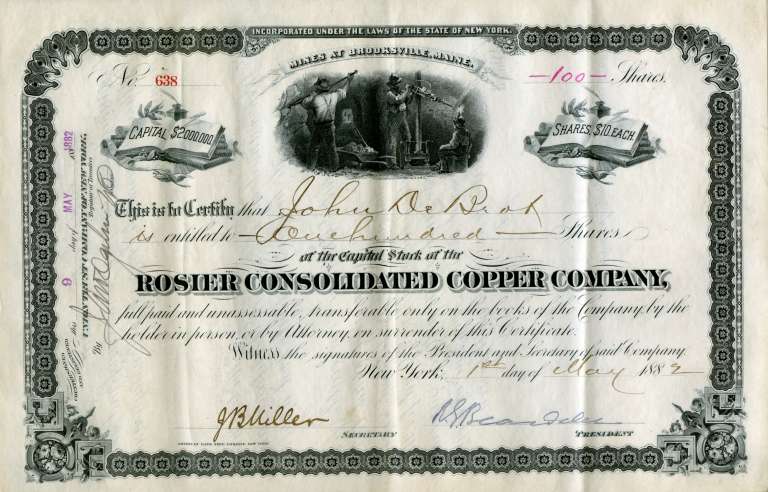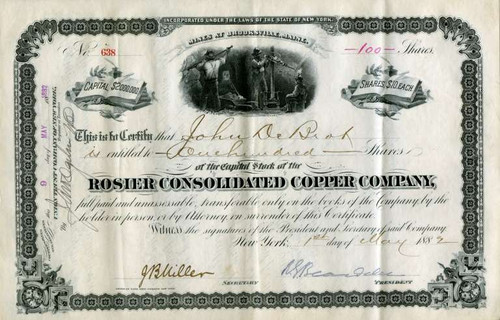Beautifully engraved stock certificate from the Rosier Consolidated Copper Company issued in 1882. This historic document was printed by the American Banknote Company and has an ornate border around it with a vignette of men working underground in a mine. This item has the hand signatures of the Company's President, R. G. Beardslee and Secretary, J. B. Miller. 
Certificate History of Metal Mining in Maine Blackhawk MineProbably the earliest commercial operation in Maine was the mining of bog iron in Newfield, a small scale operation that continued for many years. Other enterprises in the mid-1800's included a lead mine near Lubec and the Katahdin Iron Works north of Brownville Junction. A mining boom swept Maine from 1879 to 1882. In a great flurry of excitement small mines and prospects were opened in many areas, primarily along the coastal volcanic belt from Blue Hill to Lubec. Iron, silver, copper, lead, and zinc were mined, milled, concentrated, and smelted. A sudden drop in prices in 1883 caused most of the mines to close as fast as they had opened. Sporadic activity continued until 1918 when production of base metals in Maine ceased for almost 50 years. During World War II, the US and Maine governments launched an intensive exploration program for manganese, an element on the War Department's "strategic list," that had been discovered in Aroostook County in the mid-1800's. This effort showed that a large amount of manganese is present, but the ore was never mined because an efficient process for extracting the ore was not available. The next round of Maine mineral exploration came in the late 1950's after the discovery of large ore deposits in nearby Bathurst, New Brunswick. While much attention was again focused on Maine's coastal volcanic belt, the inland volcanic belt from northwestern to northern Maine was also examined. From these efforts, part of an ore body estimated at 4.5 million tons was worked near Blue Hill in 1964-65. A significant nickel-copper deposit in Union was discovered and drilled, but not mined. Probably the most famous operation was the open-pit Harborside mine between Brooksville and Cape Rosier that produced 800,000 tons of copper and zinc ore from 1968 to 1972. The largest producer was the Black Hawk mine near Blue Hill, an underground mine that produced an estimated 1,000,000 tons of zinc-copper-lead ore between 1972 and 1977. No metals have been mined in Maine since 1977. The high level of exploration from the mid-1970's to early 1990's produced several important discoveries. Among these were the Ledge Ridge deposit in Parmachenee (1973), a massive sulfide with several million tons of zinc, lead, copper; the Bald Mountain deposit west of Portage (1977), a large massive copper-zinc sulfide deposit with an estimated 36 million tons of ore; the Mount Chase copper-lead-zinc-silver deposit near Patten (1979), and the Alder Pond deposit (1985), with an estimated 1.5 to 3 million tons of high grade copper-zinc ore underground. While some of these sites may be developed in the future, none of these deposits have yet been mined. Brooksville is a town in Hancock County, Maine, United States. As of the 2010 census, the town population was 934. It contains the villages of North Brooksville, South Brooksville (on Buck's Harbor), West Brooksville, Brooksville Corner, and Harborside (on Cape Rosier). It was first settled by John Wasson, Samuel Wasson and David Hawes, soldiers in the Revolutionary War. Incorporated on June 13, 1817, the town was formed from parts of Castine, Penobscot and Sedgwick. It was named Brooksville after Governor John Brooks of Massachusetts, which then governed Maine. The surface of the town abounds with granite, and several quarries were established. The soil is a clay loam, which yielded wheat and potatoes. Buck's Harbor, safe and deep, is one of the best coves in the region for small boats, and many residents became involved in the coasting trade and fisheries. By 1880, when the population was 1,419, Brooksville had a porgy oil factory, two sawmills, a shingle mill, a planing mill, two gristmills, a wool carding mill, and a cloth and yarn factory. Shipping was an industry, with ship repairs done at the foot of Wasson's Wharf Road with a pier to the channel in the Bagaduce. There was a brickyard, blacksmith's shop, rope walk and small store for provisions. As late as 1912, there were 18 schooners at the wharf under repair. A small packet, the Goldenrod, ferried passengers from Brooksville to Castine and there was a pier to the south where the Belfast boat berthed. The Wasson and Tapley families, related by marriage, had numerous ship's captains, the most notable being the six Tapley sons of Captain Robert Tapley, who all followed the sea after their father. History from Encyberpedia, Maine.gov and OldCompany.com (old stock certificate research service)

Certificate








